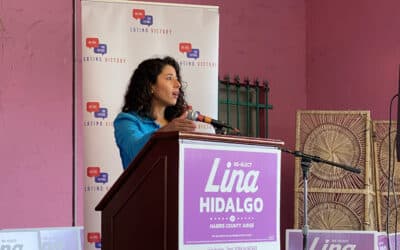Half a century of voter discrimination
Texas has been found in violation of the Voting Rights Act of 1965 because of intentional racial discrimination every decade since its enactment. The root of these violations is redistricting, the process of redrawing the boundaries of every congressional and state legislative district to maintain roughly equal populations, a process that occurs every 10 years after collecting new census data. A select group within the Texas Legislature is the architect and cartographer of this endeavor.
For the last half-century, lawmakers have often advanced their own political interests by intentionally weakening the political power of voters of color by packing them into select districts, or splitting them across several districts — a practice commonly known as racial gerrymandering. As a result, Texas has been subject to more federal objections to discriminatory voting changes than any other state.
In media coverage of redistricting and gerrymandering, the focus is often placed on political parties and politicians — those drawn out of their districts, or those who lose their reelection because of unfavorable new district contours. At the end of the day, however, the people most adversely affected by political mapmaking are the voters of color whose voting power is intentionally weakened.
Looking ahead to 2020, lessons learned from the most recent 2010 redistricting cycle provide a painful reminder that while legislators often reap political power, it is voters of color, not politicians, who are drawn out of the canvass.
“[From 2000 to 2010], Texas grew by 4 million people, and 90 percent of them were minorities. Yet, not a single minority received an additional seat in Congress because of that growth. Not a single one went to the minority community even though they brought all the growth,” said Texas House Rep. Trey Martinez Fischer, who chaired the Mexican American Legislative Caucus (MALC) during the last redistricting cycle. “That’s what’s wrong with partisan redistricting. That’s what needs to change.”
Despite Texas being allocated four additional congressional seats in 2010 due to explosive growth of Latinx and Black residents, only a single new seat was won by a person of color. “The only outcome [MALC] cared about was that if minority voters chose to vote and participate in an election, and they could vote for the candidate of their choice, they may have a chance to prevail. An honest opportunity to compete,” said Rep. Martinez Fischer.
This is the heart of Texas’ long history of intentional discrimination against voters of color: Because voters of color were packed into single districts or broken up across several districts, their voting power is diluted to the point that their votes are rendered ineffective in choosing their political representation.
Texas’ historical pattern of discrimination placed it under “preclearance” in Section 5 of the Voting Rights Act, a federal oversight measure that forced the state to get new district maps and voting right laws cleared by the U.S. Department of Justice or a federal court before going into effect. Preclearance proved, for decades, to safeguard against the most egregious violations of disenfranchisement of voters of color. The original 2010 redistricting plan, designed in 2011 by the Republican-dominated Texas Legislature, failed to obtain preclearance because the redrawn district lines would constrain the voting power of voters of color. Court-drawn interim maps were imposed as a result.
“The process was extremely partisan, the membership on the committee was very lopsided—12 [Republicans] to 5 [Democrats],” said state Sen. Carol Alvarado, a Houston Democrat who served on the 2011 House Redistricting Committee and will serve on the 2021 Senate Redistricting Committee. “Transparency was also an issue. We often saw that a map was given to the Democrats and the public to be considered for public testimony for the committee. However, the alternate map, the real map, was being drawn by Republican leadership.”
Soon after the original 2010 redistricting plan was redrawn in 2011, the U.S. Supreme Court struck down the preclearance law in Shelby v. Holder in 2013, giving Texas a new unchecked power in creating voting laws and passing redistricting plans. The day after the preclearance safeguard was removed, a modified redistricting plan was signed into law. An analysis showed that the plan helped Texas Republicans win more U.S. House seats through redistricting than any other state.
“Under preclearance, Texas had to prove that it was not undermining the ability of underrepresented minority voters to select a candidate of their choice. Now, the burden of proof goes from Texas Republicans to Texas Democrats. Now, the process starts, and then the challenge occurs,” said Mark Jones, a professor of political science at Rice University. “That’s a very profound difference. You could very well see a plan that is approved and challenged, but stays enforced for a couple of years while it moves through the courts.”
The 2010 redistricting cycle was marked by a decade-long legal struggle, and Republican-drawn district maps accumulated almost 10 separate court rulings of intentional racial discrimination. A notable 2018 lawsuit, Abbott v. Perez, again challenged the redrawn maps as unconstitutional, and sought to reimpose preclearance. However, in another blow to the voters subject to racial gerrymandering, the Supreme Court ruled that the districts could remain as is, with the exception of one district, and that Texas could continue without preclearance.
“It means that, after years of litigation and undeniable proof of intentional discrimination, minority voters in Texas — despite constituting a majority of the population within the State — will continue to be underrepresented in the political process,” wrote Justice Sonia Sotomayor in a 46-page dissent.

Lessons learned from the last decade of redistricting: prepare early, advocate for transparency, solicit public testimony, & don’t politicize voters of color
“The most important thing I thought we could have done is to prepare ourselves both financially and emotionally to be willing to be the voice for minority voters and stand up to the state of Texas,” said Rep. Martinez Fischer who made multiple appearances in the federal courthouse and traveled to Washington, D.C. for litigation challenges led by the Mexican American Legislative Caucus (MALC). “Whether it’s at the state house or the court house, we will fight them tooth and nail to preserve and protect the voting rights of minorities in our state.”
Diligent preparation for the possibility of racial discrimination, urgings for greater transparency, the importance of public input, and the desire to depoliticize redistricting were themes woven throughout several conservations with lawmakers and legal organizations about the upcoming redistricting cycle.
“The lesson learned was that the forward progress we made was made early in the litigation. It’s important to be prepared as early as possible,” said Nina Perales, the vice president of litigation at the Mexican American Legal Defense and Educational Fund (MALDEF) and lead counsel in a challenge to the 2011 redistricting plan. Perales cited MALDEF’s successful challenges of adding a House seat to the Rio Grande Valley, preventing the weakening of predominantly Latinx districts in El Paso and Bexar Counties, as well as MALC’s success in preserving a Latinx district in Harris County — all significant wins that occurred during the first two years of litigation.
Sen. Alvarado, who will be directly involved in the redistricting process as a member of the 2021 Senate Redistricting Committee, spoke of the need for greater transparency. “You always have to ask, when you’re presented with a map, is this the real map you’re supposed to work off of? Or is there some other map that somebody else is working on and we’re going to see it at the last minute and not be able to have public testimony on it, comment on it, or amend it? We learned that lesson the last time,” she said.
In an effort to increase transparency, one significant difference between the 2010 redistricting cycle, and the upcoming 2020 cycle is a series of public input hearings, led by the House and Senate Redistricting Committees, to collect public testimonials from Texans. These testimonials will help group communities which share common social and economic interests as new district maps are being drawn. The Texas Civil Rights Project successfully agitated for the geographic expansion of these public hearings, which are now spread across 23 cities. Despite hearing cancellations and undefined postponements due to the COVID-19 pandemic, Alvarado expressed hope in rescheduling most hearings, and indicated a working group is in place to determine how to proceed.
“[Texas Civil Rights Project], [Texas Freedom Network], and MOVE Texas are absolutely preparing and ready to advocate for the rescheduling of those hearings. If not in-person, then virtually,” said Ali Lozano, the voting rights outreach coordinator for the Texas Civil Rights Project. “We are making plans to come up with some sort of digital mechanism that will allow community members from all over Texas to, at the very least, submit written testimony that the [Redistricting] Committee can read.”
In part because the composition of Redistricting Committees is determined by party leadership, Democrats are hoping to sweep just 9 of 22 targeted seats in the Texas House to win a Democratic majority. For both parties, redistricting is at the center of the pitch to encourage voters to turn out in November. However, redistricting is not an issue fundamentally defined as red versus blue.
“We have seen attempts to dilute minority voting strength and racially gerrymander minority voters from incumbents who are Democrat and Republican,” said Nina Perales of MALDEF, citing a 2018 case in which MALDEF litigated and won a claim of racial gerrymandering perpetuated by a Democratic incumbent facing reelection against a Latino. “We are litigating for the interest of minority voters without being tied to the interests of incumbents or political parties.”
“The future of the franchise for minority voting rights in Texas really is not just something that is a benefit to Democrats,” said Rep. Martinez Fischer, a Democrat. “Both political parties have the opportunity to compete for the minority vote.”
The upcoming struggle for political power for voters of color
Texas is predicted to gain 3 additional congressional seats because of continued population growth of residents of color, setting up another redistricting battle. Without the effective layer of preclearance oversight ahead of the 2020 redistricting cycle, advocacy organizations, and civil rights and voting rights groups are preparing to fill the void.
“Certainly the loss of Section 5 preclearance poses a very serious threat to minority voting rights, and we’re going to have to meet that challenge case by case until Congress restores some aspect of preclearance,” said Nina Perales of MALDEF. “We may be able to use other parts of the Voting Rights Act as alternative tools.”
“We’re ready to sue. Without preclearance, our attorneys are being very vigilant about ways in which we can utilize the law to protect communities of color and voters of color,” said Ali Lozano of the Texas Civil Rights Project.
One disadvantage, though, is that advocacy and legal groups need to raise adequate funding to engage in sustained litigation against racial gerrymandering. The state of Texas, however, can use tax dollars — including taxes contributed by the voters of color being discriminated against — to fund their litigation. “There’s something wrong with that,” said Rep. Martinez Fischer of the state’s ability to self-fund court battles.
Another upcoming challenge will be the fair and accurate enumeration of the district’s population because of delays in the 2020 census due to COVID-19 and possible legal challenges. The Supreme Court recently rejected a Texas resident’s charge that districts should be drawn based solely on eligible voting population, not total population.
“You have to count individuals — regardless of their age, whether they’re eligible to vote, their citizenship,” said Alvarado, who represents a district that is over 75 percent Latinx. “Their representation is important.”
Texas prisons, which are disproportionately comprised of black and brown people, pose a significant challenge in fair enumeration. Currently, Texas counts incarcerated people as residents of the prison location, rather than the home that they will return to following release. The Texas Civil Rights Project is advocating for the state to count incarcerated people at their home addresses to ensure that their electoral power is not diluted in their home districts.
The dilution of voting power in Texas, which is almost 40 percent Latinx, however, is not equal among all communities of color. “When we talk about representation of people of color, African Americans are by and large represented in proportion to their population. The severe underrepresentation is with Latinos and to a lesser extent Asian Americans,” said Mark Jones of Rice University.
The struggle for political power for voters of color, especially for severely underrepresented Latinx voters, is far from over. “Voting rights is a marathon, not a sprint,” noted Rep. Martinez Fischer, who plans to continue his involvement in protecting voting power. Lawmakers and advocacy organizations are preparing for a contentious 2020 redistricting cycle, drawing on lessons from the last decade—prepare early, advocate for transparency, solicit public testimony, and don’t politicize voters of color.
“We are always prepared to go to court if we have to,” said Nina Perales of MALDEF. “We can hope for the best and plan for the worst.”
Photo: Sarah L. Voisin/The Washington Post via Getty Images
Chris covers Texas politics and government. He is a Policy Advisor for Harris County Judge Lina Hidalgo and a graduate student at Harvard University. Previously, Chris served as Texas State Director and National Barnstorm Director for Bernie Sanders’ presidential campaign, and as a Political Advisor for Beto O’Rourke. Born in Houston, Texas to immigrants from Hong Kong and Mexico, he is committed to building political power for working people and communities of color. Chris is a Fulbright Scholar and a graduate of Rice University.




